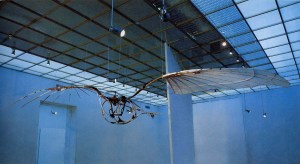Vladimir Tatlin’s Letatlin was built between 1929 and 1931. Considered as his last major work, Tatlin came up with the name by combining the Russian word “letat”, meaning “to fly”, and his last name.[1] The structure itself was a full-sized model of a human glider/flying apparatus that Tatlin revised into several other manifests of the original glider. Letatlin was inspired by Tatlin’s fascination with the flight patterns of birds and insects, as well as his belief that art should live outside of an enclosed frame or space and should be built from simple, organic materials.[2]
The several models of Letatlin were constructed by assembling parts of rawhide, cork, steel cable, wood, and even added a whale bone for extra strength at the points that connected most of the pieces together, therefore absorbing most of the stress[3]. Tatlin made sure that all of the materials used were functional, flexible, and were selected on the principle of their best possible use, a common and important belief amongst Russian Constructivists. Tatlin finished off each model by covering them with strong silk. Most models took on a very earthly, complex structure by reflecting the bone structures and feathers of birds. Tatlin based Letatlin’s structure not only by studying the flight patterns of birds and insects, but by dissecting them to analyze the musculature and bone structure, “…in order to calculate the necessary ratio of body mass to wing span that would make it possible to replicate the strength and flexibility of their wings and ability to stay aloft.”[4] The Letatlin was built on the platform of the Russian Constructivist belief that art should be practical, functional, and serve people; In this case, it would have given flight to its users.
Tatlin created the Letatlin for several reasons. He wanted to not only build this glider to serve, he also wanted to build it to unite communities and give its users a liberating, almost spiritual experience. Tatlin often attributed his initial inspiration to the Greek mythology character Icarus. “The dream is as old as Icarus… I too want to give back to man the feeling of flight. This we have been robbed of by the mechanical flight of the aeroplane. We cannot feel the movement of our body in the air.”[5] Tatlin was also ecologically aware of the harmful fumes and by-products made by airplanes and other aspects of the urban environment, which led him to make the glider what he called an “air bike”, since it would be manually pedaled by the user and contain no motor to further contaminate the air. He also despised the forms that were made by modern engineers, saying, “The engineers made hard forms. Evil. With angles. They are easily broken. The world is round and soft.”[6] Tatlin felt that creating the Letatlin would give humans the liberating feeling of natural, non-urbanized flight, a feeling that humans are not able to experience in an airplane. The Letatlin was used as a symbol to remind humanity that seemingly complex, industrialized objects can be made with simple, organic, and unprocessed materials, also meaning that pollution caused by urbanization didn’t have to be an option.
The Letatlin models were great examples of Russian Constructivist approach to art, with all of the models being made of natural, simple, organic materials that were constructed to make a practical and functional work that could not only be viewed by people but serve them as well.
[1] Christina Lodder, Russian Constructivism (Connecticut: Yale University Press, 1983), 213.
[2] Gray, Camilla. The Russian Experiment in Art: 1863-1922. London: Thames and Hudson, 1962
[3] Frederickson, Laurel. 1999. “Vision and Material Practice: Vladimir Tatlin and the Design of Everyday Objects”. Design Issues 15, no. 1: 49.
[4] Frederickson, 68
[5] Lodder, 213
[6] Lodder, 214*
